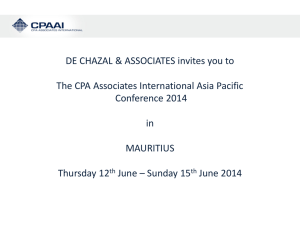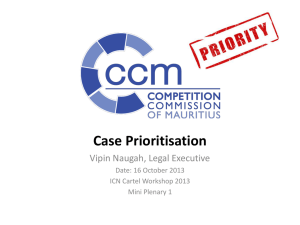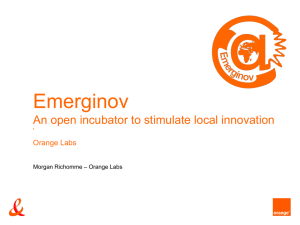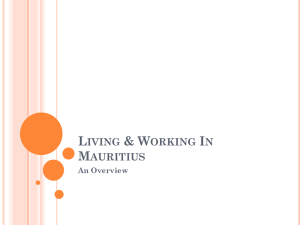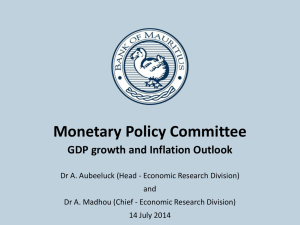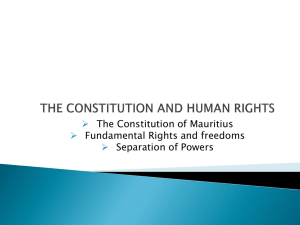Anil Jhugroo
advertisement
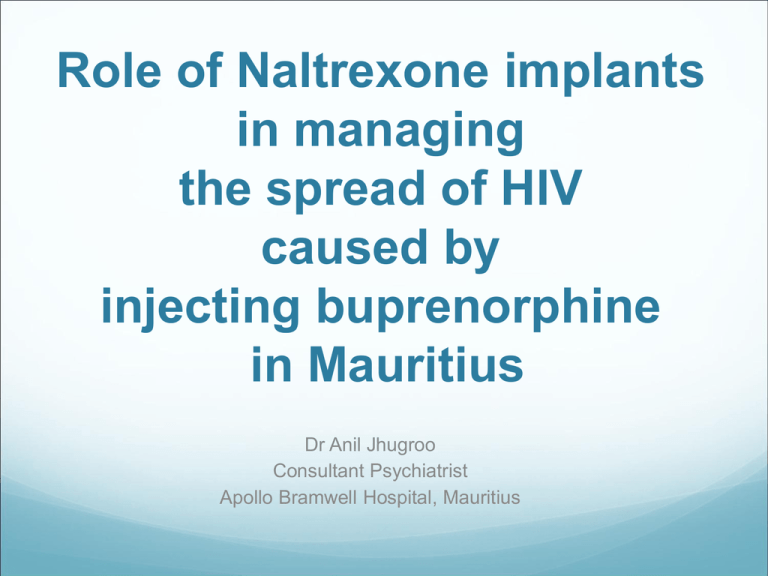
Role of Naltrexone implants in managing the spread of HIV caused by injecting buprenorphine in Mauritius Dr Anil Jhugroo Consultant Psychiatrist Apollo Bramwell Hospital, Mauritius 1.2 million inhabitants Indian/African/Chinese/European/Mixed race Nearly one million Tourists/year Textile and Sugar industry Stable democracy About 2 % of population are believed to be injecting drug users, World Drug report, 2010 About 2 % of the 14-49 year-old group is believed to be HIV positive. 23 % of prison inmates have tested HIV positive over the last year OPIATE USE PER CAPITA, 2010 WORLD OPIATE USE PER CAPITA OTHER COUNTRIES USE/CAPITA 1. Iran 2.8% New Zealand 2. Costa Rica 2.7% England & Wales 0.8% 3. Afghanistan 2.7% Kenya 0.7% 4. Mauritius 2.0% USA 0.6% 5. Russian Federation 1.6% France 0.5% 6. Scotland 1.5% Egypt 0.4% 7. Estonia 1.5% Australia 0.4% 8. Malaysia 1.3% South Africa 0.4% 9. Ukraine 1.2% Greece 0.3% 10. Puerto Rico 1.2% Jamaica 0.1% 11. Macao 1.1% Singapore 0.01% Source :United Nations Office on Drugs and Crime, 2010 1.1% Report of the International Narcotics Control Board for 2009 “There is evidence of an increase in the smuggling of heroin to the islands of the Indian Ocean, particularly Mauritius. Opiates from India and Pakistan are smuggled into Mozambique and then South Africa and from South Africa into Europe, as well as into East African countries, notably Mauritius and Seychelles. Mauritius now has one of the highest levels of opiate abuse in Africa, a spillover effect of the heroin trafficking in that country.” From heroin to buprenorphine… Heroin 80’s & 90’s purity getting lower (higher purity in the Seychelles) has lesser desired effect difficulty with chasing, usually injected. is expensive shorter lasting More difficult to smuggle Buprenorphine Drug dealers: easier in importing and concealing; more lucrative. IVDU: cheaper & lasts longer (cheaper than marijuana) Last decade, demand and supply in favour of buprenorphine Currently accounts for about 80% of drug used by IVDU in Mauritius IVDU buy one eighth of this 8-mg pill at about Rs 300 (7.50 euros) • Buprenorphine seizures: about 80 000 tablets in 2007 and about 40 000 tablets in 2008. • Price has fallen from Rs 3,000 (75 euros) a tablet to Rs 1,200 (30 euros) a tablet over past 2 yrs. • Changing pattern of drug selling: • extensive use of mobile phone; • cleaner to handle • coming from other countries POLICE SEIZURES Heroin 2007 5,7 kilos 2008 11,5 kilos 2009 9,5 kilos Buprenorphine 2007 79 617 tablets 2008 38 770 tablets IVDU & HIV/AIDS “Mauritius also has a high prevalence of injecting drug use and a concentrated HIV epidemic among these users.” World drug report, 2010 Number of injecting drug users in Mauritius estimated at between 10,000 and 18,000 people. “Prevalence of HIV in Mauritius estimated at 1.8% representing approximately 12,000 people” UNAIDS in 2007 Harm reduction programmes In recent years Mauritius has recognised the seriousness of its injecting drug use problem and injection driven HIV, scaling up harm reduction programmes in the form of Needle & Syringe exchange programme First African country Started Nov 2006 46 sites across the island About 5,400 registered users out of 10,000-18,000 IVDU Methadone substitution programme Introduced in 2006 About 3,000 on treatment Information campaign TV and radio Posters • Between 2007 and 2010, • 24 opiate dependent patients travelled to Perth from Mauritius to have the O’Neil double Naltrexone implant • Went in batches of 4-6, accompanied by care workers • 4 of them later had repeat Naltrexone implants • Upon return to Mauritius, reviewed regularly by their care workers for general follow up and to assess their level of opiate abstinence. • Random urine drug screening tests were also performed Duration of abstinence Number of opiateabstinent patients Total number of patients in study 6 months 24 24 1 year 20 24 1½ years 11 24 2 years 10 24 2½ years 10 24 3 years 7 18 4 years 5 13 Never relapsed 10 24 Currently abstinent 13 24 Percentage of opiate free patients after 1st implant at follow up 6 months 100 % 1 year 83 % 1½ years 46 % 2 years 42 % 2½ years 42 % 3 years 39 % 4 years 38 % Abstinence over time after first implant Benefit of 2nd implant After 1st implant, 42 % remained fully abstinent (10 out of 24) Four patients had repeat implants In the period between 6 to 18 months after the 1st implant Three of them following relapses One was still abstinent but wanted prophylactic treatment More wanted to have repeat implant but had visa restrictions After 2nd implant, All 4 remained abstinent from opiates to date. 54 % are currently abstinent (13 out of 24) Of those 11 patients who are currently in relapse, 7 are on a methadone programme (29%) 4 have gone back to injecting heroin or buprenorphine (17%) After 2nd Naltrexone implant Among those who relapsed Reasons for relapses An identifiable precipitating factor Relationship difficulties Work related problems Reasons for not repeating naltrexone implants Visa restrictions • as not locally available Financial reasons • Costs of travel and accomodation abroad If available locally and at appropriate pricing, would be considered by all those who have relapsed •To minimise risk of relapses, • Need to perform Naltrexone implant operation in Mauritius •Less expensive •Local support •No visa restrictions • Infrastructure facility and trained staff available • Current discussions with Government officials to set up unit.
